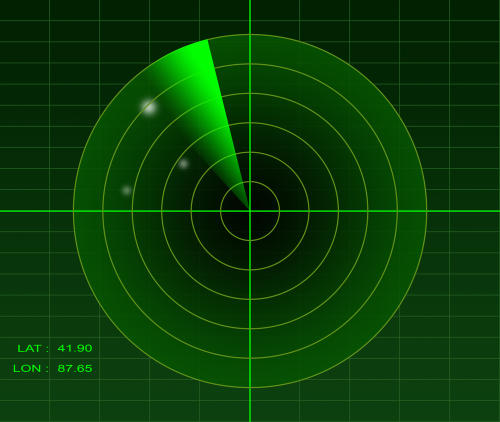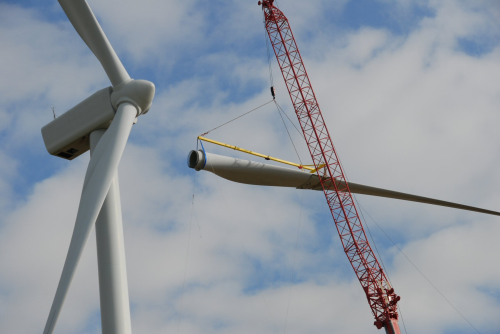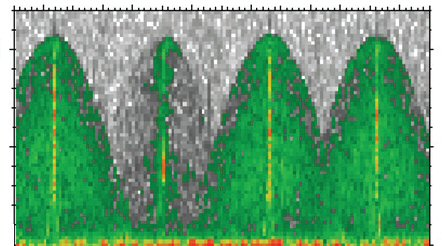



There is a need to make certain objects invisible, or at least less visible, to radar. Such objects range from submarine periscopes to complete warships, from stealth aircraft to wind turbines. Materials science can meet this need, providing materials that absorb the incident microwave energy – radar absorbing materials (RAM) – or complete structures designed to do the same thing – radar absorbing structures (RAS). A number of solutions incorporate reinforced plastics and other composites.
Radar energy can be 'lost' in two main ways:
- by being absorbed into a material that converts it into another form of energy such as heat; and
- by destructive interference.
In the former, the electric or magnetic fields of the radiation react with the material properties and energy is thereby consumed. In the latter case, incident waves are cancelled out by antiphase reflections, the necessary 180° phase shift being achieved by reflecting surfaces that are spaced a nominal quarter wavelength apart. Some RAMs and RAS utilise both principles.
Useful elements include conductive materials that can reflect radar waves, dielectric materials that are largely transparent to radar, and magnetic materials that absorb energy electromagnetically. RAMs can be engineered by loading dielectric materials with conductive, reflective and magnetic elements. As many plastics are natural dielectrics, they can be used as a basis for such solutions.
RAMs
RAMs have a history practically as long as that of radar itself. German submarines in World War 2 had their periscopes coated with a 0.3 inch layer of 'Wesch' material comprising a rubber substrate loaded with carbonyl iron powder. The conductive powder particles served to dissipate radar energy into the substrate material. Sizing the particles so that they resonate at the frequency of the radar being countered enables more energy to be absorbed, and Wesch resonated at the frequency of allied S-band search radars.
This concept has since been widely used. American researchers developed Halpern Anti-Radiation Paint (HARP) which, for airborne use, was just 0.025 in thick. This carried within its rubber matrix aluminium flakes and carbon black particles sized for X-band resonance. By the 1970s, various radar absorbing paints were in production, containing a range of materials from evaporated metal alloys to fibrous carbon, while more volumetric absorbers were being made from foams, knitted structures or coated honeycomb. Conducting polymers, including polymer coated fibres and fabrics, have entered the portfolio of available materials.
Absorbers can be made narrowband or broadband, depending on the nature of the radar threat or hazard. One narrowband approach is the Salisbury Screen, in which a sheet of resistive material overlays a conductive back plane, the two being separated by dielectric material whose thickness is a quarter of the subject radar's wavelength. Incident radar waves penetrate the outer layer and are reflected from the inner, backplane layer, some of the energy then being re-reflected from the inside of the outer layer. During subsequent internal reflections, waves that have been 180° shifted due to the quarter wavelength separation between the two surfaces meet other waves that have not been so shifted and the two cancel each other out. The energy liberated is dissipated within the central absorbing material.
A single Salisbury layer can absorb a specific narrow frequency band, but if broader-band protection is required, multiple resistive sheets can be laid up over a common back plane. Each sheet has different characteristics so that different frequencies are absorbed, the overall arrangement being dubbed a Jaumann absorber. In either case, the 'active' layers can be made from reinforced plastics, typically glass reinforced plastic (GRP) with added resistive elements for the 'window' layer, and carbon/epoxy for the common back plane. The electrical conductivity of carbon means that carbon composite lends itself to back plane use, as an alternative to metal. The precise properties required are engineered by selecting the type, orientation and amount of carbon reinforcement.
Stealth composite absorbers are made by loading matrices with electromagnetic materials ranging from metallic particles to carbon nanotubes. Thus, for example, carbon impregnated polyurethane foam, carbon-loaded silicone and neoprene, and iron-loaded urethane are among material combinations known to soak up microwave energy. Chinese researchers have laminated RAM with face sheets of glass and carbon fibre/epoxy composite sandwiching polyurethane foam doped with carbon nanotubes. Korean workers who have experimented with polypropylene fibres with bronze and ferrite inclusions report that this approach also works well. A plethora of foams and coatings that can reduce radar signature now make up a highly active sector of the microwave materials market.
RAS
Composites come into greater focus when considering radar absorbing structures. Reinforced plastic materials are known for their unique combination of low weight with high strength, stiffness and fatigue resistance, but their electromagnetic (EM) characteristics are important too; witness, for example, glass fibre reinforced plastic (GRP)-based printed circuit boards and carbon composite electromagnetic interference (EMI) shielding enclosures for sensitive electronic equipment. Low-weight RAS can be made from glass and carbon fibre composite lattices in which the voids are occupied by microwave absorbent foams. Absorption effectiveness would be related to the volume fraction of the grid cell structure and the distance between elements.
In radio/radar frequency (RF) absorbers, carbon composite can be used instead of metal for conductive backplanes, as can metallised fabrics and conductive polymers. Further potential lies in combining the conductive properties of carbon fibre with low (dielectric) loss GRP in textile composites having tailored electromagnetic properties. In particular, frequency selective fabric composites (FSFCs) can be produced by weaving glass and carbon fibres together in particular patterns. Such fabrics can be both load bearing and RF energy absorbing. Furthermore, they can be mass produced using existing fabrication processes so that their use to protect large assets, such as ships and aircraft, becomes feasible.
FSFCs can be incorporated as integral elements of composite structures. For example, South Korean researchers have described a 3.5 mm thick, vacuum bagged and autoclaved RAS that comprises a carbon and glass FSFC layer embedded between two 'standard' composite layers. The FSFC is fabricated as a plain-weave incorporating T300 carbon fibres and E-glass fibres, within an epoxy matrix, with a carbon nanotube filler added to help dissipate RF energy internally.
Wind farms
A highly topical application of RAS technology is wind turbines. Plans for wind farms are routinely vetoed by defence ministries and air traffic control services on the grounds that they interfere with radar, making it difficult to track aircraft.
Large rotor blades are particularly challenging. Even though their predominantly GRP skin and foam core construction has low radar reflectivity, internal features such as metal lightning conductors, carbon reinforcement and solid laminate sections give rise to significant reflections. Moreover, blade movement can defeat radars that combat interference by filtering out all targets that are not moving. (The technique is known as moving target indication, or MTI). This is especially the case when blades are rotating in a plane edge on to the radar, creating Doppler effect.
Wind farm interference can create ghosting, false targets and clutter, causing target confusion or loss. Hostile aircraft could use wind farms to their advantage, for example hiding in the radar 'shadow' or clutter produced by a large farm. UK research and technology company QinetiQ has developed a software model that can predict the effect on radar of a wind turbine as a function of blade yaw and pitch.
The radar signature of towers and nacelles can be minimised with RAM coatings – paints, foams etc – and similar solutions have been tried on some rotor blades. But RAM coatings tend to be thick and, in the case of blades, would add mass and bulk to elements for which low weight and precise shaping are important. They may be insufficiently flexible to accommodate blades' natural bending, and they can spoil aerodynamic flow by being less smooth than the moulded finish. Coating operations also add to production costs. It would be far better to be able to integrate a radar absorbing layer within the original laminate, at the point of lay-up.
Prototype stealth blade
Enter leading wind turbine manufacturer Vestas Wind Systems and QinetiQ. After working together on the radar issue, the two organisations recently demonstrated a prototype stealth blade that is a classic example of a RAS. Tested on a Vestas V90 turbine at Swaffham Wind Park in Norfolk, UK, in October 2009, the stealth product reflected much less radar energy than a standard version of the 44 m long blade, according to Steve Appleton, now a researcher at Vestas' R&D centre on the Isle of Wight, UK (he previously worked on stealth materials at Qinetiq).
QinetiQ has provided the technology with which Vestas aims to start producing and marketing stealth blades, probably some time next year.
According to Dr David Moore, business development manager for QinetiQ’s Materials and Energy Business, the solution arrived at with Vestas results in a marginal mass increase and has no adverse effect on structural integrity. As he tells Reinforced Plastics: "It is a purely passive fit-and-forget solution that is an integral part of the composite structure. It has a minimal effect on blade weight and will require no on-going attention."
The solution is also said to be affordable.
"In addressing the issue of blade reflectivity for S-band radars, we have tackled the most difficult aspect of the wind turbine/radar problem," Moore points out. "There were technical solutions available, but the biggest challenge lay in finding one that the wind energy sector would be able to afford, bearing in mind that it could never contemplate cost levels normally associated with stealth in defence markets. Many experts said it couldn't be done."
|
Present RAM/RAS technology, sophisticated though it is, may be made to seem archaic by an emerging class of materials that could make Harry Potter's fictional 'invisibility cloak' a reality. Metamaterials are composite materials with extaordinary capabilities to bend electromagnetic waves, including light and radio waves, so that they 'flow' round an object, like a river round a rock. Thus only the background behind the object is left visible, to an eye, radar or other EM radiation detecting sensor, not the object itself. ‘Invisibility cloaks’ fashioned from metamaterials could be used to hide items from view, whether optically at very high frequencies, or from radar at lower microwave frequencies. What singles out this mysterious class of artificially created materials is that they have a negative refraction index, in contrast to materials found in nature that have a positive index. Some metamaterials are based on the physics of resonance, but others developed more recently do not rely on this phenomenon. Clearly, these are no ordinary composites. For a start, there has to be a structural array with pattern dimensions smaller than the electromagnetic wavelength being used. Thus a 'fishnet' patterned material has been described. Materials are generally based on interacting nano particles or coils held in a medium such as glass or polymer. A handful of British mathematicians first proved that metamaterials could create invisibility, while American researchers have followed up by developing materials that can actually bring this about. So far, most success has been achieved in narrow bands of the microwave spectrum, but more recent work has replicated the effect over greater bandwidths and for light. Small wonder that the US defence interests are actively exploring the stealth possibilities of metamaterials. Given the relatively long wavelenths in which radar operates, it is likely that invisibiity to radar will be viably achieved well before its optical counterpart. However, the technology is in its early stages and it will be some years before nano-coated 'invisibility cloaks' will be available for wind turbine blades and other civilian structures. |
The new stealth material is used as fabric interlayers within laminates produced by standard blade production processes – primarily wet lay-up, resin infusion or prepreg. While QinetiQ is guarded over details, it describes its composite-friendly solution as basically standard glass cloths modified to confer the required characteristics. As such, the stealth fabrics are no thicker, heavier or more difficult to handle than the composite materials normally used in blade manufacture. They are readily included in solid laminate and are thin enough for use in sandwich skins as well.
Although firm details are not available, it seems unlikely that a conventional Salisbury Screen or Jaumann approach is involved since a composite with face skins the necessary quarter wavelength apart would be an unfeasible 25 mm thick (for an S-band radar). A credible hypothesis is that the solution involves resonant absorption achieved by loading the composite matrix with appropriate particles of carbon or other conductive material. Selection of specific particle lengths and other characteristics would enable even thin composites to be 'tuned' electromagnetically to the required frequency band. This solution is likely to have been combined with engineered impedance matching, the aim being to avoid electrical impedance discontinuities – invisible electromagnetic boundaries within the material that are known to reflect microwaves.
For the static parts of a wind turbine (tower, nacelle etc) the collaborative partners have also developed a RAM coating that combines both microwave absorption and destructive interference to combat the frequencies used by aircraft tracking radars. A substrate loaded with conductive and/or magnetic particles provides the absorption, while applying the appropriate coating thickness secures destructive interference. The loading is more likely to be carbon than iron or ferrite based to avoid risk of future corrosion.
While conceding that a stealth turbine is bound to be more costly than a non-stealth equivalent, Vestas and QinetiQ claim to have established that the industry will consider the extra cost bearable when it enables a potential wind farm to be sited where it would otherwise be barred.
David Moore believes that RAM and RAS solutions will a game changer, transforming the prospects for onshore and offshore wind farms sited within line of sight of radars. He suggests that there are three zones of risk around a radar:
- a far zone where stealth solutions are not necessary;
- a less distant zone where RAM and RAS are called for; and
- a near zone where RAM/RAS measures must be combined with sophisticated electronic filters added to the radar.
There is also an inner zone extremely close to the radar where no combination of measures will sufficiently counter the interference problem, and here wind turbine siting would be inappropriate. Now that solutions are available for S-band aircraft tracking radars, QinetiQ says it will be easier to develop RAM and RAS solutions for radars that operate at higher frequencies, such as marine and weather radars.
Now the partners are moving on to a further demonstration phase in which they will trial a full stealth wind turbine, complete with tower, nacelle and three-bladed rotor, designed for use with S-band radars. Reinforced Plastics understands that this could happen by the end of this year. Although, naturally, other organisations are addressing the wind turbine/radar problem as well - witness, for instance, the UK's Blade Runner initiative in which a consortium including microwave materials specialist HITEK Electronic Materials has been working on a blade solution along with a layered broadband absorber for use on towers and metal structures - the Vestas/QinetiQ team believe they have a viable answer that is working now, is already in demand and could soon be available in the market place. If their confidence turns out to be well founded, large wind turbine blades could soon become the highest profile examples of radar absorbing structures, constituting a promising niche market for very specifically engineered composites.
This article was published in the November/December 2010 issue of Reinforced Plastics magazine.





